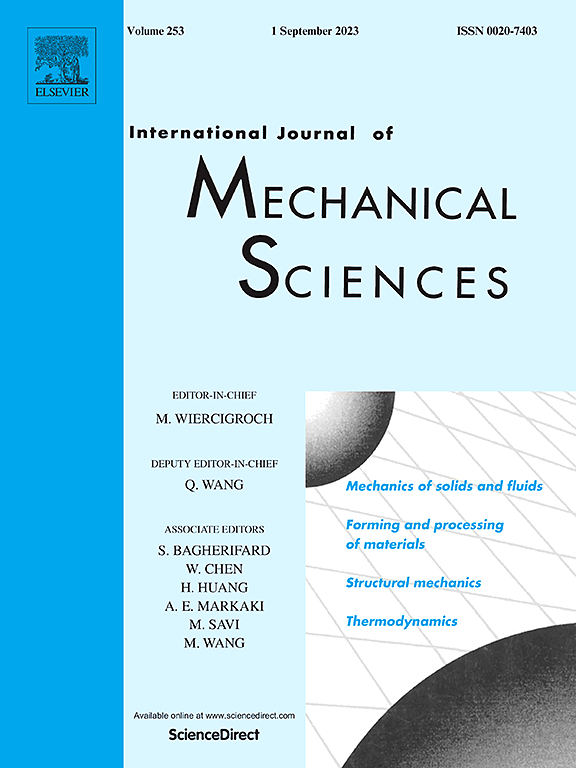SFEM-4DP: A strain-based finite element model for 4D printing
IF 7.1
1区 工程技术
Q1 ENGINEERING, MECHANICAL
International Journal of Mechanical Sciences
Pub Date : 2025-07-11
DOI:10.1016/j.ijmecsci.2025.110497
引用次数: 0
Abstract
Four-dimensional (4D) printing extends three-dimensional (3D) printing by adding a time-based dimension, allowing printed structures to change and adapt over time. This smart behavior is built into smart materials during printing and activated by external stimuli. Unlike 3D-printed static structures, 4D-printed structures evolve, offering dynamic functionality for various applications. This study opens up new avenues for efficient modeling of 4D-printed structures by introducing a Strain-based Finite Element Model for 4D Printing (SFEM-4DP) that predicts time-dependent deformation behavior. By incorporating viscoelastic effects and nonlinear Green strain formulation, the proposed model captures large deformations while simplifying the modeling process and reducing the need for extensive parameter identification. A simulation tool is developed to implement the model and facilitate practical 4D printing predictions. Several numerical simulation cases are used to demonstrate the model’s flexibility and efficiency. The experimental verification include hydrogel doughnuts and bilayer composites of thermoplastic polyurethane (TPU) and hydrogel, demonstrating the model’s capability of dynamic deformation prediction. Finally, two application cases of soft robotics-a transformable wheel and a soft gripper-are demonstrated based on the bilayer composites.

smem - 4dp:一种基于应变的4D打印有限元模型
四维(4D)打印通过增加基于时间的维度来扩展三维(3D)打印,允许打印结构随时间变化和适应。这种智能行为在打印过程中被内置到智能材料中,并由外部刺激激活。与3d打印的静态结构不同,3d打印结构可以不断发展,为各种应用提供动态功能。本研究通过引入一种基于应变的4D打印有限元模型(smem - 4dp)来预测随时间变化的变形行为,为4D打印结构的有效建模开辟了新的途径。通过结合粘弹性效应和非线性格林应变公式,该模型可以捕获大变形,同时简化建模过程,减少对大量参数识别的需要。开发了仿真工具来实现模型并促进实际的4D打印预测。通过数值仿真实例验证了该模型的灵活性和有效性。实验验证包括水凝胶甜甜圈和热塑性聚氨酯(TPU)与水凝胶的双层复合材料,验证了该模型的动态变形预测能力。最后,给出了基于双层复合材料的柔性机器人的两个应用实例——可变形车轮和柔性夹持器。
本文章由计算机程序翻译,如有差异,请以英文原文为准。
求助全文
约1分钟内获得全文
求助全文
来源期刊

International Journal of Mechanical Sciences
工程技术-工程:机械
CiteScore
12.80
自引率
17.80%
发文量
769
审稿时长
19 days
期刊介绍:
The International Journal of Mechanical Sciences (IJMS) serves as a global platform for the publication and dissemination of original research that contributes to a deeper scientific understanding of the fundamental disciplines within mechanical, civil, and material engineering.
The primary focus of IJMS is to showcase innovative and ground-breaking work that utilizes analytical and computational modeling techniques, such as Finite Element Method (FEM), Boundary Element Method (BEM), and mesh-free methods, among others. These modeling methods are applied to diverse fields including rigid-body mechanics (e.g., dynamics, vibration, stability), structural mechanics, metal forming, advanced materials (e.g., metals, composites, cellular, smart) behavior and applications, impact mechanics, strain localization, and other nonlinear effects (e.g., large deflections, plasticity, fracture).
Additionally, IJMS covers the realms of fluid mechanics (both external and internal flows), tribology, thermodynamics, and materials processing. These subjects collectively form the core of the journal's content.
In summary, IJMS provides a prestigious platform for researchers to present their original contributions, shedding light on analytical and computational modeling methods in various areas of mechanical engineering, as well as exploring the behavior and application of advanced materials, fluid mechanics, thermodynamics, and materials processing.
 求助内容:
求助内容: 应助结果提醒方式:
应助结果提醒方式:


